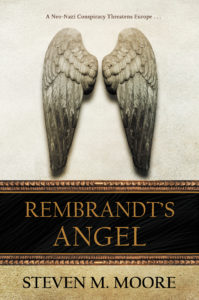Time and FTL travel…
Time travel is barely mentioned in Sing a Zamba Galactica (second novel in The Chaos Chronicles Trilogy Collection); faster-than-light (FTL) travel plays a key role in unifying the planets of near-Earth space into ITUIP (Interstellar Trade Union of Independent Planets). If that doesn’t sound strange enough, consider that both time and FTL travel are linked in that trilogy by similar physics.
The star systems of the first three Human colonies were reached by old interplanetary rigs that took around a hundred years to travel there at sublight speeds. Only after first contact with ETs on the planet New Haven in the 82 Eridani system did two physicists, one Human, the other ET, come up with the foundations for an FTL drive.
While time travel was mentioned in an oblique way in Sing a Zamba Galactica, and later in the Moliere-like farce “The Apprentice” (short story in the speculative fiction collection Pasodobles in a Quantum Stringscape, Volume Two, available as a free download—see my “Free Stuff & Contests” web page), I tend to avoid the topic. It’s rarely well-handled, even ignoring the many paradoxes that often occur in a plot (both of the previously mentioned stories avoid them).
If authors want to transport readers back to the past, steampunk might be the better option. It’s a subgenre of sci-fi or fantasy (the line, as is often the case, is blurry) that in general asks the question, “What would the world be like if recent important inventions were actually made in the past?” In other words, steampunk is alternate history, and that’s a clue for treating time and FTL travel correctly (i.e. without paradoxes or contradicting Einstein).
I learned about the “Many Worlds Theory of Quantum Mechanics” when studying the origins of how Professor Feynman came to quantize classical fields, the electromagnetic field in particular. Some people, even physicists, associate his quantization technique to what are now called Feynman diagrams, simplistic shorthand for studying a series of terms that contribute to the answer. That is too simplistic.
Feynman’s technique was really motivated by the idea that all paths of a particle, say an electron, are possible, but some paths are more probable than others, where the probability is obtained via a complex function by taking the square of its magnitude. What’s now called the Feynman path integral is just a mathematical representation of this idea, and from that comes the diagrams.
But the tale doesn’t end there. Feynman was a student of Professor Wheeler, and so was Hugh Everett III. The latter’s Princeton thesis provided an alternative foundation for quantum mechanics that’s far superior to the old Bohr interpretation, using “quantum paths” (in quantum gravity discussions, these are called “quantum histories”). Feynman co-opted these ideas for his path integral.
Time travel comes in the following way: Consider the Universe and all its mass, energy, and space-time as a physical object. The state of that object we experience is just one of many according to quantum mechanics. The erstwhile time traveler can avoid all the paradoxes by just appearing in an alternate universe, another state. Because that fits in well with the multiverse/metaverse/string theory concepts (see Brian Greene’s The Elegant Universe), I used it both for my version of FTL travel and the few instances of time travel I’ve considered in my fiction. Hopping among the multiverses covers both time travel (moving through different times) and FTL travel (moving through different spaces), which can appear to be faster than light in our own.
I can’t claim originality for doing this, at least not for time travel. Although James Hogan didn’t consider FTL travel, his The Proteus Operation combines time travel with the Many Worlds Theory of Quantum Mechanics to eliminate paradoxes. Classic sci-fi at its best, and the only major novel about time travel to do it right.
So forget The Time Traveler’s Wife and other silly romances filled with paradoxes—read Hogan’s book instead. (He has other good ones too.) You don’t have to know quantum mechanics or Everett’s theory to enjoy it either—or my stories, for that matter. And be assured that it’s still speculative fiction—time travel isn’t possible…yet. Neither is FTL travel to the stars, whether done with a warp drive using dilithium crystals or some other plot device.
***
Comments are always welcome.
Rembrandt’s Angel. How far would you go to recover a Rembrandt stolen by the Nazis in World War II? Scotland Yard Inspector Esther Brookstone, of the Art and Antiques Division will provide one answer to that question. Paramour and Interpol Agent Bastiann van Coevorden tries to keep her safe in her quest to recover the painting, but the duo uncover something much more—a vast conspiracy that threatens Europe. Available in ebook format on Amazon and Smashwords and all the latter’s affiliated retailers (iBooks, B&N, Kobo, etc) and in print on Amazon and in your favorite local bookstore (if they don’t have it, ask them for it). It’s also available at the publisher, Penmore Press.

Around the world and to the stars! In libris libertas!
